The tawny frogmouth is a crazy-cute, meme-worthy, owl-like bird from Australia. In this post, you’ll learn 32 tawny frogmouth facts, including diet, lifespan, habitat, size, and more. Plus lots of beautiful photos and videos.
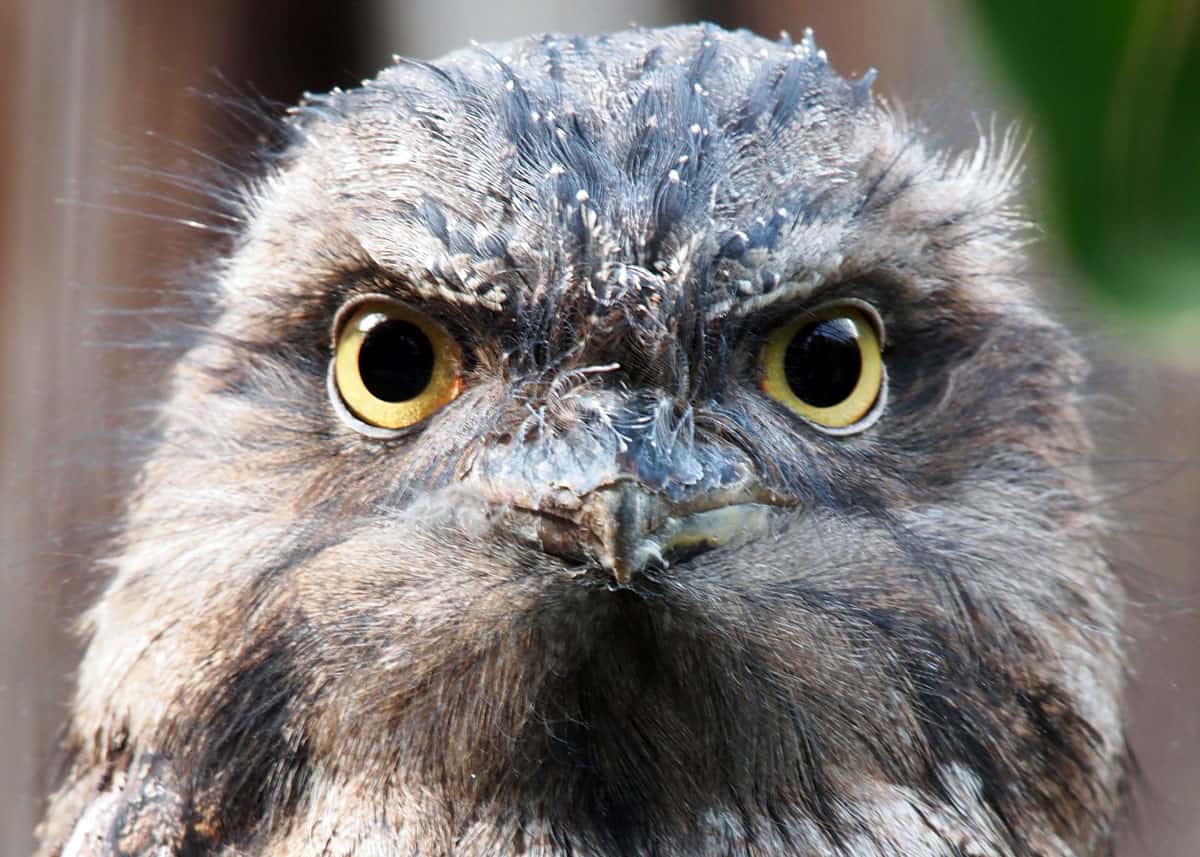
Table of Contents
32 Tawny Frogmouth Facts: What You Need To Know
Tawny frogmouths are masters of disguise. Blending into the gray-spotted trees of Australia, they’re often mistaken for owls, nightjars and other kinds of birds, but they don’t actually belong to these species.
They aren’t tawny or shaped like a frog, either. Everything about their name and appearance is deceptive!
What are tawny frogmouths? What do they do? How do they live? Let’s take a look at some tawny frogmouth facts to learn more about these feathery little ninjas.
1. What does the tawny frogmouth look like?
If you can spot the tawny frogmouth in a tree, half of the battle is already won. They have a remarkable ability to camouflage themselves among the trunks and branches of Australia’s native pines.
Watch on YouTube
Their feathers are a combination of white, black, brown, gray and silver. They have short bodies with large heads and flexible necks.
When they feel threatened, they’ll crane their necks and point their beaks towards the sky; this gives them the appearance of a broken branch, and predators will often fall for the ruse and slink away.
As for their bodies, they’re generally short and stocky. They aren’t very large except for when they stretch their wings.
Love funny looking birds? Check out our post: 17 of the Weirdest Birds in the World
2. Can tawny frogmouths come in other colors?
While most tawny frogmouths have monotone colors, there have been reports of all-white specimens with albinism.
However, they’re so rare that not many pictures exist; they’ve only been discussed in ornithology journals. Here’s a photo of an albino tawny frogmouth from December 2006.
3. Are tawny frogmouths owls?
No. Tawny frogmouths are often confused with owls since they have similar habits and colors, but the only real thing that they have in common is that they’re both birds.
They don’t even belong to the same genus.
Three Differences Between Tawny Frogmouths and Owls
If you need to tell the difference between owls and tawny frogmouths in the wild, the easiest way is to look at their faces:
- Eyes: front-facing (owls), side-facing (tawny frogmouths)
- Beaks: downward-sloping (owls), front-rising (tawny frogmouths)
- Facial disks: yes (owls), no (tawny frogmouths)
4. Are tawny frogmouths nightjars?
Tawny frogmouths are more related to nightjars than owls, but they’re still separate species on different branches of the family tree.
Frogmouths are under the podargidae label; nightjars are classified as caprimulgidae.
Watch on YouTube
5. Are tawny frogmouths nocturnal?
Yes, tawny frogmouths are nocturnal birds. They rest during the day and become active at dusk.
However, they aren’t totally dormant during daylight hours; they’ve been known to sit with their beaks open and snap up any unsuspecting insects that crawl inside.
6. How big is a tawny frogmouth?
Most tawny frogmouths measure around 13 – 21 inches in height.
7. How much does a tawny frogmouth weigh?
In the wild, tawny frogmouths weigh between 5 – 20 ounces. This is a big range, but it encompasses all of the different sub-species and the size differences between males and females.
The heaviest tawny frogmouth on record weighed 1.5 pounds, but he was considered an exception to the rule.
8. What is the tawny frogmouth’s wingspan?
The wingspan of a tawny frogmouth is 2 – 3 feet. It might not seem like a lot, but when you see these large wings stretch out from a short, compact body, the sight can be pretty amazing!
9. How did the tawny frogmouth get its name?
One of the biggest questions about tawny frogmouths is where they got such an odd name. Why didn’t people call them “owl lookalikes” or something else more suitable?
Well, their scientific name is exactly that: Podargus strigoides comes from the Latin for “owl” (strix) and “form” (oides).
As for their everyday name, “tawny frogmouth” is more appropriate than it might appear on first glance. Some of their sub-species have a reddish-brown coloring rather than a silver-gray one, so they could be considered tawny.
They also have wide, hook-tipped beaks that they use to catch bugs and small reptiles, so “frogmouth” is rather apt.
10. Are tawny frogmouths friendly?
Tawny frogmouths aren’t dangerous to humans, but calling them friendly is a bit of a stretch.
They’re shy, secretive birds that don’t like to come out of their carefully-camouflaged nests, and their primary defense mechanism is to freeze and pose like a tree branch in hopes that the danger will simply keep moving.
They can be trained to accept things like grooming and hand-feeding by wildlife keepers, but it takes time, patience and a deep well of dedication.
11. Are tawny frogmouths aggressive?
Tawny frogmouths aren’t an aggressive species. They might lash out when extremely frightened or panicked, and they show no mercy when swooping down to catch their prey, but they’re gentle creatures on the whole.
In fact, one of the more unusual characteristics of the tawny frogmouth is that males and females don’t play dominance games with one another.
They mate in peaceful, monogamous pairs, and they both sit on their eggs when it’s time to incubate. They even cuddle in trees by sitting closely together and grooming each other with soft beak strokes through their partner’s plumage.
12. Can tawny frogmouths fly?
Tawny frogmouths are capable of short-distance flights, but anything more than that is difficult. They simply aren’t built for long hauls or high altitudes.
Their flying ability is limited to fluttering among tree branches and diving to the ground when they spot something juicy to eat.
13. How long do tawny frogmouths live?
Tawny frogmouths can live for 10 – 15 years in the wild. It’s been suggested that they might last longer in captivity.
14. What eats a tawny frogmouth? Predators and Threats
In the wild, tawny frogmouths are preyed on by foxes, snakes, and falcons. When they venture too close to residential areas, they’re at the mercy of domestic dogs and cats.
Another danger for tawny frogmouths is egg-thieving. There are many animals that like to steal and eat their protein-rich eggs, including ravens, rodents, pythons, currawongs, and butcherbirds.
Some of these predators will also eat baby frogmouth hatchlings.
15. Is the tawny frogmouth endangered?
The International Union for the Conservation of Nature (IUCN) has the tawny frogmouth listed as “least concern” with a widespread habitat and a stable population.
You don’t have to worry about these birds. They aren’t going anywhere for a while.
16. What do tawny frogmouths eat?
Tawny frogmouths are carnivores that eat insects, rodents, reptiles, amphibians, and other small creatures. They’re considered a natural method of pest control since they can rid an area of bugs and vermin.
As night hunters, their diet mostly consists of nocturnal prey such as moths, spiders, slugs, beetles, worms and snails. They can take down the occasional lizard or scorpion.
Something to note about tawny frogmouths is that they don’t catch their prey with their feet.
Unlike owls, they don’t have strong legs that can carry animals over long distances, so they’re forced to swoop down and make their kills with their beaks.
Once their prey is dead, they’ll fly back to the camouflage of their trees and enjoy their prize there. If they stay on the ground, they risk being caught by a predator themselves.
17. What is the tawny frogmouth’s Latin name?
The scientific name of the tawny frogmouth is podargus strigoides. There are also three sub-species:
- Podargus strigoides phalaenoides (Northern Australia)
- Podargus strigoides brachypterus (Western Australia)
- Podargus strigoides strigoides (Eastern and Southern Australia as well as Tasmania)
18. What family does the tawny frogmouth belong to?
The tawny frogmouth is from the podargidae family.
It includes several other species of frogmouth birds, including the marbled frogmouth and the Papuan frogmouth.
19. What other names does the tawny frogmouth have?
The tawny frogmouth is occasionally called the “freckled frogmouth” or “tawny-shouldered frogmouth.”
You might also hear incorrect names like “mopoke.” The mopoke is a type of Australian owl that has a call similar to the tawny frogmouth’s, so it’s yet another case of mistaken identities.
20. Do tawny frogmouths mate for life?
Yes, tawny frogmouths mate for life. Their partnerships are lifelong and surprisingly domestic.
Male-female pairs have been known to stay within a specific territory for 10 years or more!
21. At what age do tawny frogmouth lay eggs?
Tawny frogmouths reach sexual maturity around 1 – 1.5 years. Their mating season is from August to December.
22. How many eggs does the tawny frogmouth lay?
Tawny frogmouths usually lay 1 – 3 eggs at a time. The incubation period is around 30 days, and both males and females will take part in it.
Dad will sit on the nest during the day; mom will take over at night while dad catches some food and comes back to feed her.
23. What are baby tawny frogmouths like?
Hatchlings are small, blind, wrinkled and covered in a soft down. It takes them about 10 days to open their eyes for the first time, and it takes about 20 days for their feathers to start growing.
Hatchlings are completely dependent on their parents at the beginning of their lives. They’re also quite vulnerable to predators; they’re helpless to anything that wants to sneak into the nest and grab them.
Watch the first 26 days of this tawny frogmouth chick at the Saint Louis Zoo:
Watch on YouTube
The good news is that both male and female frogmouths look after their young, so babies have double the chance to survive to adulthood.
Mom and dad work together with everything from building the nest to feeding their hungry children.
A typical feeding involves catching an insect, grinding it against their beaks and either dropping or regurgitating it directly into their hatchlings’ mouths.
24. What is the tawny frogmouth’s call?
Tawny frogmouths have a sophisticated range of sounds:
- They have a specific call for family members when they’re apart.
- If they’re feeling threatened, they can make hissing and clanking noises with their beaks.
- If they’re feeling annoyed, they can emit a low-pitched warning buzz that sounds like a bee.
- Males and females can perform duets during mating season.
- Hatchlings can produce a number of sounds to convey hunger, fear, distress, and injury. These are all unique to the situation and the emotion.
- At night, tawny frogmouths can produce deep, rhythmic humming noises. These noises are usually heard continuously for hours at a time with multiple noises per second. They’re the frogmouth version of hoots.
Here’s a video that shows one of the calls, a soft, deep, continuous, ‘ooo–ooo–ooo‘ sound.
Watch on YouTube
Watch on YouTube
25. Are tawny frogmouths loud?
It depends on your definition of “loud.” Tawny frogmouths don’t communicate at ear-splitting volumes, but as you just read, they’re quite vocal.
They can call, croak, buzz, hiss, and hum all night long. This might bother you if they’re right outside of your window!
26. Can tawny frogmouths regulate their temperatures?
Yes. Living in Australia, tawny frogmouths have to contend with blistering summers and freezing winters, so they have complex internal systems to help them cope with both the heat and the cold.
For example, in the summertime, they can triple their breathing rate and engorge their blood vessels to allow more oxygen into their bodies. In the winter, they can slow their heart rate and metabolism by entering a torpor state.
They’re also pretty smart about the weather in general. When it’s hot outside, they’ll move to lower branches with ample shade.
When it cools off, they’ll hop to higher branches to expose themselves to more light and warmth. They’ve even been known to sunbathe by standing in the sunlight with their eyes closed and their beaks wide open.
27. Do tawny frogmouths carry disease?
There have been a few cases of tawny frogmouths carrying angiostrongylus cantonensis, a type of parasitic lungworm that can cause illness in humans. However, it’s unknown whether the frogmouths have actually spread it anywhere.
Angiostrongylus cantonensis is generally transmitted by rats and snails, and since these creatures are household pests, human infections are nearly always their handiwork.
28. Where does the tawny frogmouth live?
Tawny frogmouths are native to Australia and Tasmania.
However, they can be seen all around the world in zoos, wildlife shelters, and bird sanctuaries.
29. What is the habitat of the tawny frogmouth?
Tawny frogmouths live in trees, so they frequent woodlands, shrublands, forests, and savannas. They’re also encroaching on human territory by coming into residential neighborhoods.
In these populated environments, they usually make their homes in bushes, yards, parks, porches and other places with shade and coverage.
30. Where do tawny frogmouths nest?
Tawny frogmouths always nest in trees. Their preferred place is a forked branch, but they’ll make do with any stable and elevated surface.
Once they’ve built a nest from twigs and leaves, they’ll re-use it over and over again. They’ll simply supplement it with new twigs if it ever becomes threadbare.
31. What threats face the tawny frogmouth?
They might not be endangered, but there are still a few things that are killing tawny frogmouths faster than they should be.
The big one is habitat loss. Since tawny frogmouths don’t like to leave their favorite territories, something like a bushfire or commercial land-clearing can be absolutely devastating for them.
They’ll stay in the ravaged area instead of moving on, and this puts them at increased risk of hunger, exposure, dehydration, and death by predator.
Another source of mortality is pesticides. In the early 1990s, the popularity of a certain termite spray in Sydney resulted in the deaths of more than 200 tawny frogmouths. They ingested it along with their prey.
In the “strange but true” category, cars are also a hazard for them. When they spot a tasty bug illuminated by a pair of headlights, they’ll dive right in front of the vehicle without realizing their impending doom.
This has resulted in quite a few frogmouth deaths, and it’s an example of how wild birds in residential neighborhoods can be a dangerous thing.
32. Where can I see the tawny frogmouth?
If you want to see the tawny frogmouth, all that you have to do is visit a local zoo. They aren’t rare creatures, so they can be found everywhere from the San Diego Zoo to the Belfast Zoo.
Of course, actually locating them in the branches of their favorite tree might prove to be difficult, but that’s why you have this guide of tawny frogmouth facts!
Armed with the knowledge of their feeding, nesting and concealing habits, you should have no problem picking them out from the crowd.
Don’t forget your binoculars as you go looking for a tawny frogmouth in the wild. Here’s how to choose the best pair.
What’s in a Name?
Some people call them owls. Some people call them nightjars or mopokes. Some people can’t even see them to call them anything.
At the end of the day, however, tawny frogmouths are their own species, and they deserve to be admired as the unique and wonderful creatures that they are.
Have you seen these cool birds in person? Did we answer your questions about the tawny frogmouth or did we miss one? Let us know in the comments!
Drew Haines is an animal enthusiast and travel writer. She loves to share her passion through her writing.
She graduated high school at sixteen and started her own business, Everywhere Wild Media. And she runs Everywhere Wild and JustBirding. She also guest blogs on Storyteller.Travel
She lived in Ecuador for 6 years and explored the Galapagos Islands. Currently based in N.S., Canada.

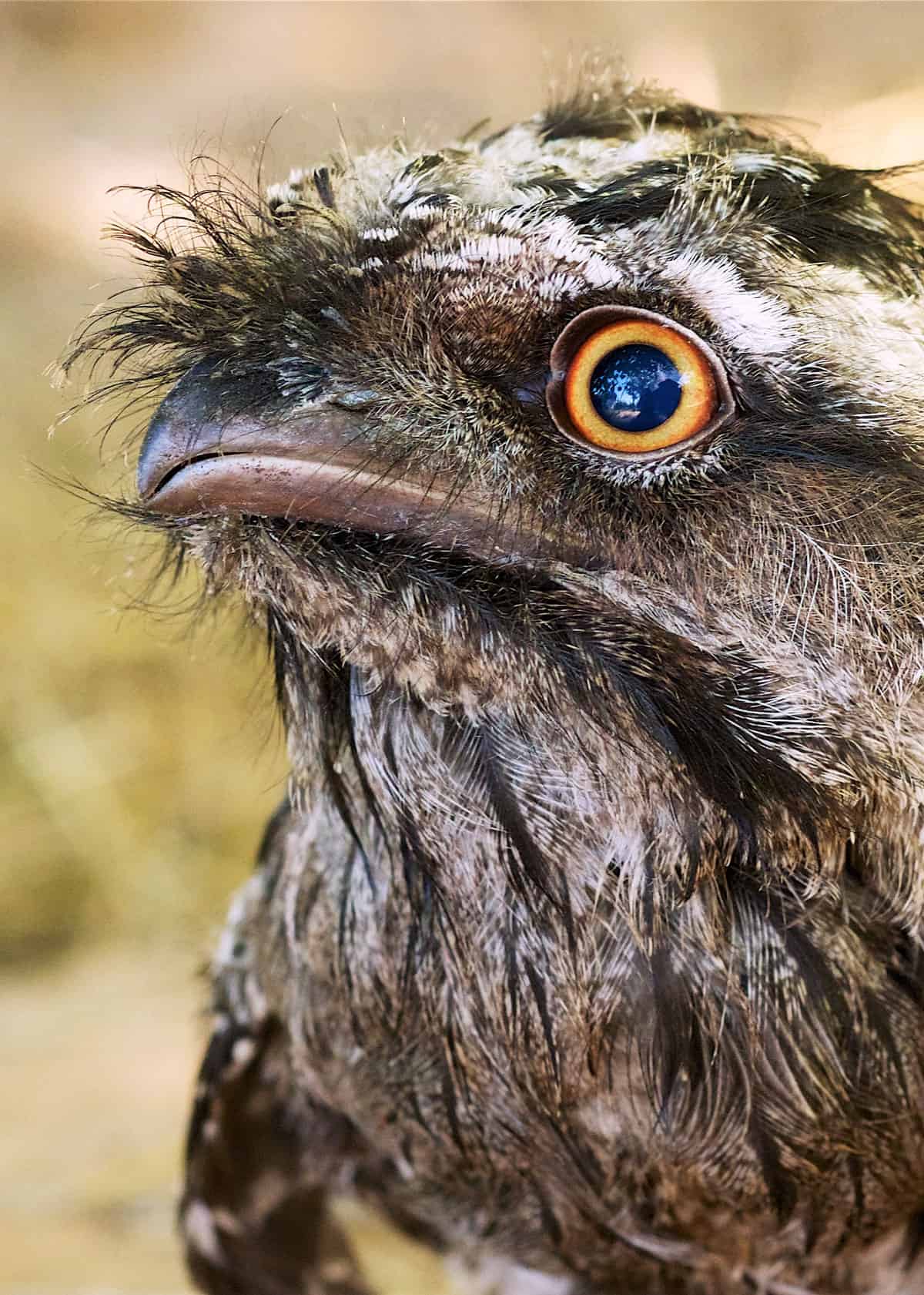
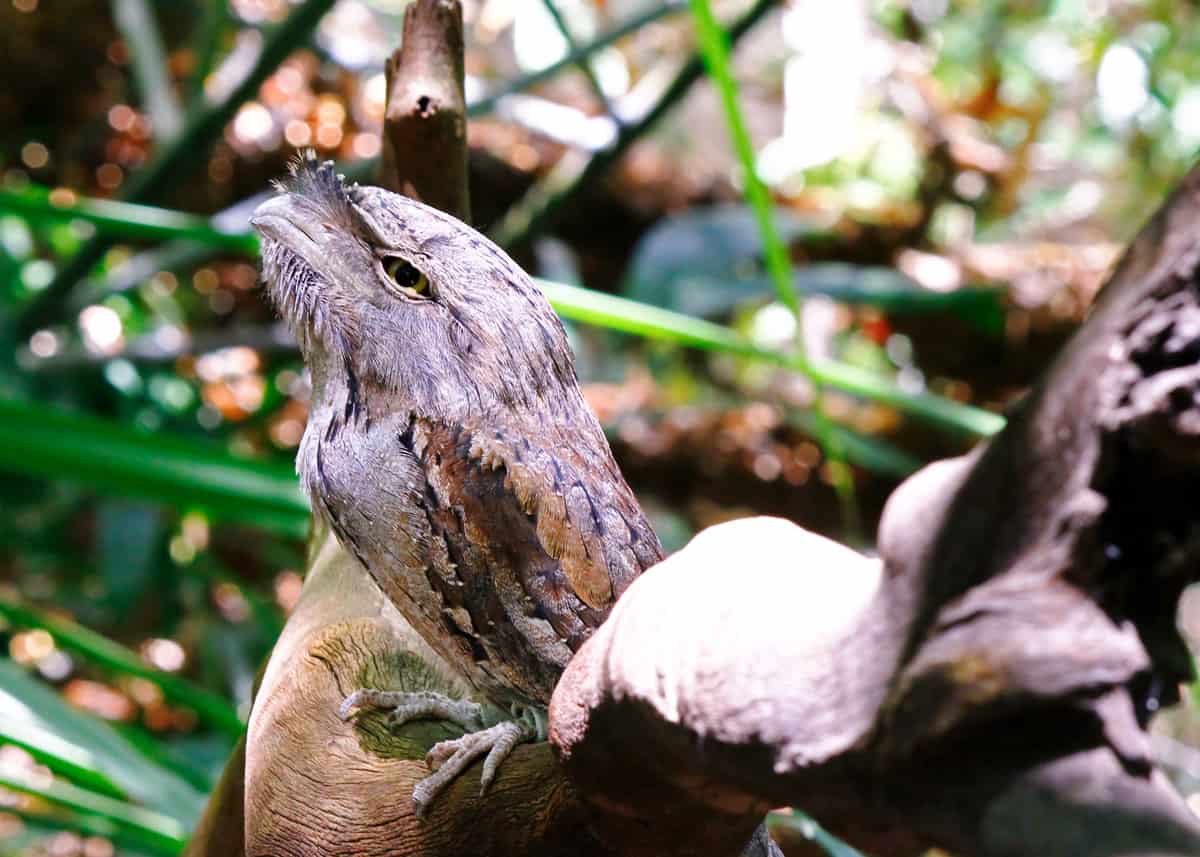
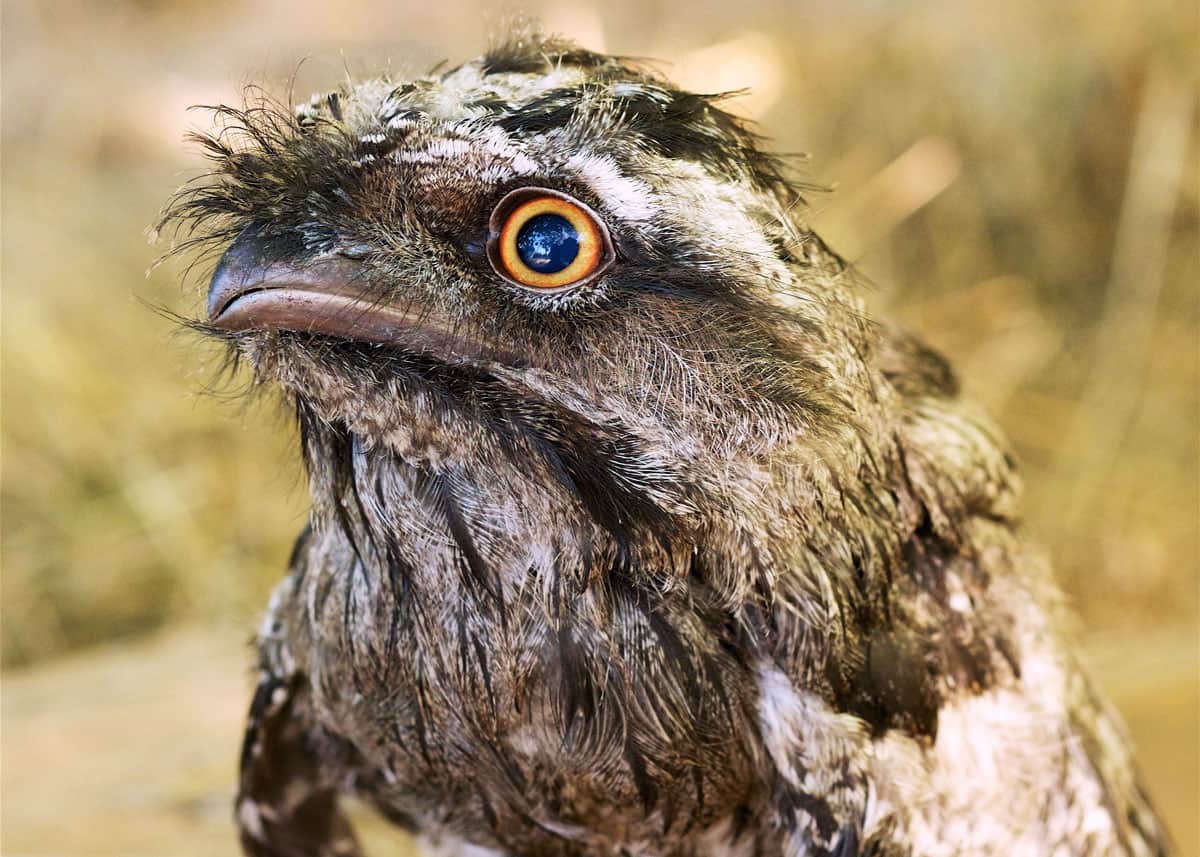
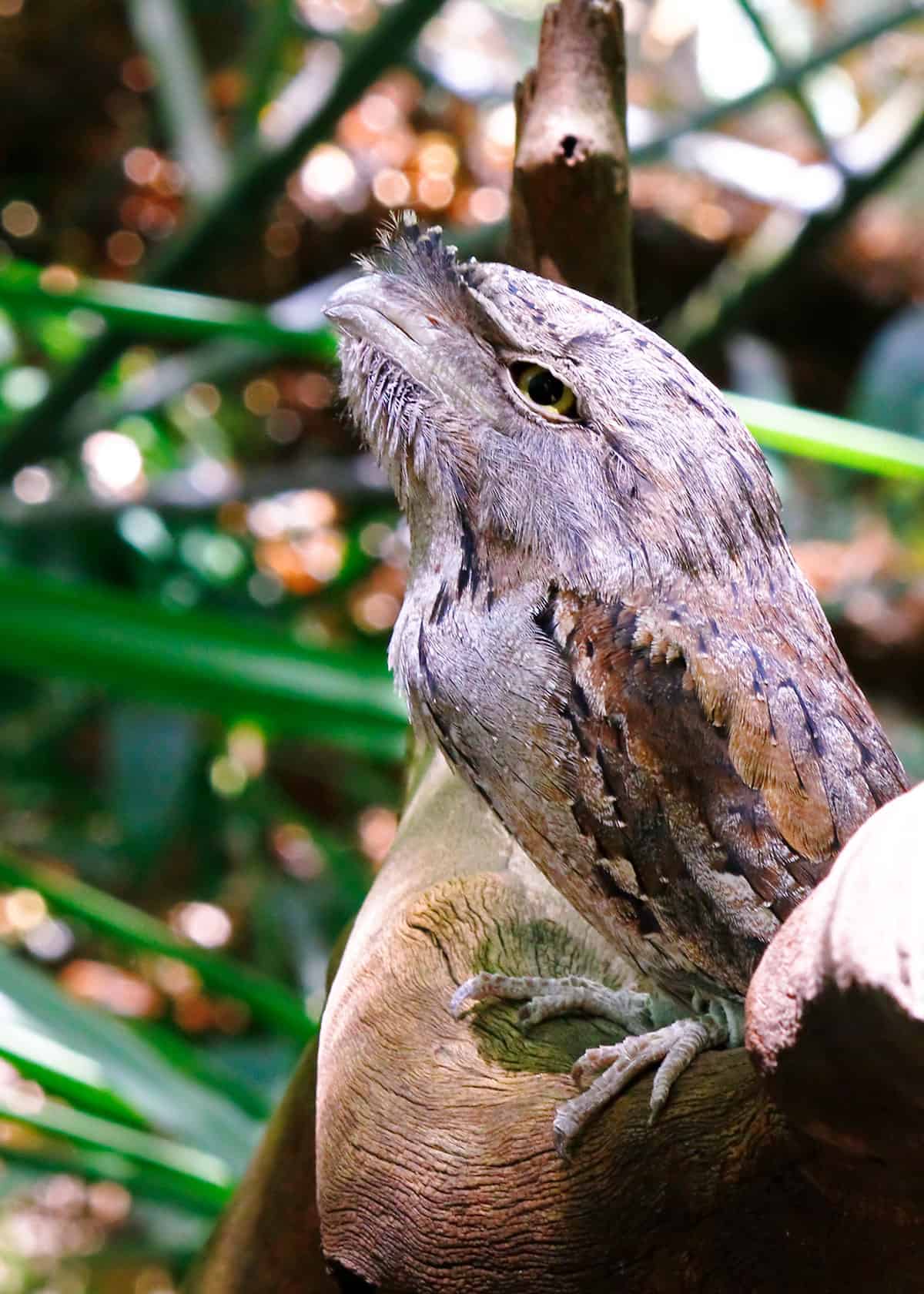
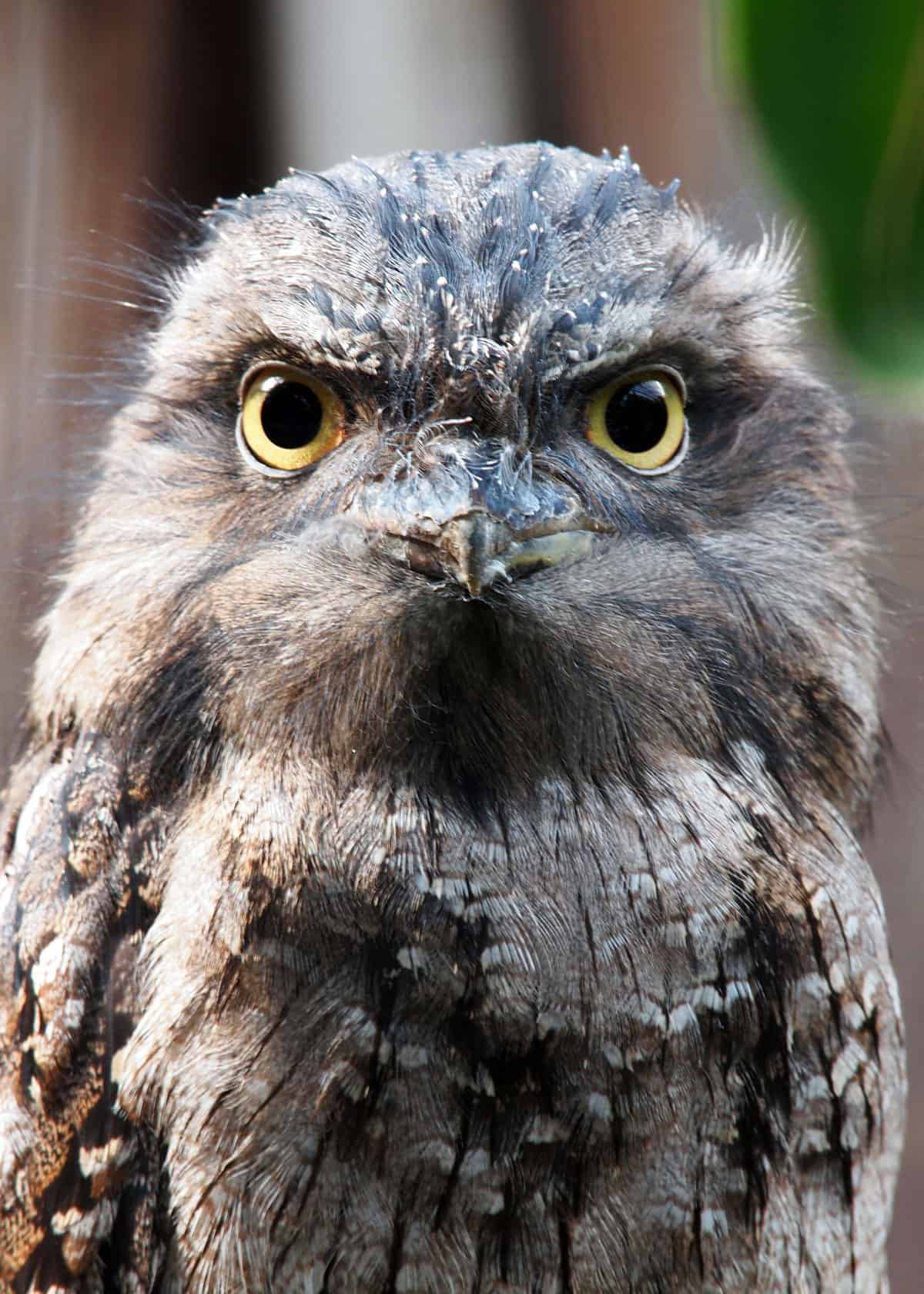
Grant
Friday 29th of September 2023
I live in Sydney's inner west. I just saw our resident tawny in the park sitting on lamp post and diving down onto the grass to feed. Its been about 6 years of seeing it around here or hearing its calls. Always amazes me the amount of wildlife for such an urban environment close the city.
Nik
Thursday 1st of June 2023
I had one on my back patio yesterday afternoon when I got home from work. He soon moved to my clothesline until dark. An hour later he reappeared and after watching me for about 10mins, he flew over and landed on my head where he sat for 20 mins til I spooked him and he flew off. He's on the back porch again now... soon I'm gonna go sit out there and see if he comes to sit on me again
Cait
Wednesday 25th of August 2021
We had a pair of tawny frogmouths in our peppercorn trees at home, and one died unexpectedly. The one left behind I believe is crying and very sad. Is it possible that this bird will meet another partner? I know they mate for life, but if this happens, can they find a new love>
Walter
Monday 10th of May 2021
Hi Drew , I just did a search to identify this poo, on our trampoline, in inner suburban Brisbane... me being German and a borderline twitcher, i know about owl poos (incl. Their *proper* name - in German), and the one my son just found looks like one: lots of fur and tiny little mouse jaws and assorted bones. I also know owls are quite rare even in the outer suburbs, so I'm suspecting it to be a tawny. So: do they poo like an owl?? What's the average size of their poo?? Pls help!
Andrew
Wednesday 14th of April 2021
I’m in a bush environment and have 2 of these birds living in the big yellow box tree right at the front of house. There’s 1000’s of trees on my property so I’m presuming for security they have chosen to live in this tree. I guess there is also a wide variety of food for them as well.